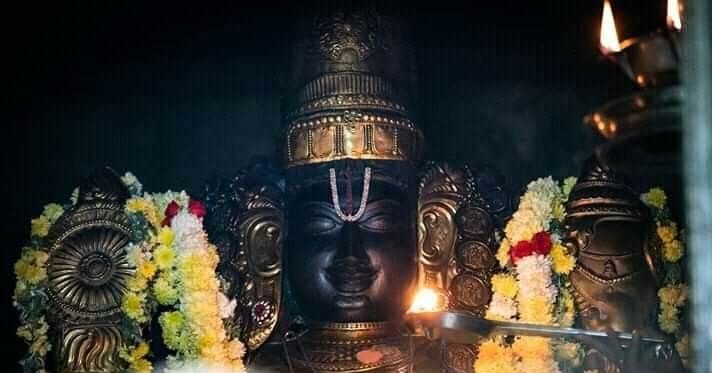one of the moksha puri
Kanchipuram, often heralded as the spiritual oasis of the South, mirrors the sanctity of Varanasi, the revered city of the North. Situated within its sacred bounds are fourteen of the 108 divya desams, making it a pivotal epicenter for divine pilgrimage. According to the ancient texts of the Garuda Purana,
अयोध्या मथुरा माया काशी काञ्ची अवन्तिका ।
पुरी द्वारावती चैव सप्तैते मोक्षदायकाः ॥
Kanchipuram is celebrated as one of the seven moksha-puris, the sanctified cities offering the ultimate liberation, standing proudly alongside Ayodhya, Mathura, Haridwar, Varanasi, Ujjain, and Dwaraka. These cities are believed to be the hallowed grounds where souls embark on their final journey towards moksha, the liberation from the cycle of birth and rebirth.
The spiritual legacy of Kanchipuram is further illuminated by the revered visit of Lord Sri Chaitanya Mahaprabhu. During his transformative journey through South India, he graced Kanchipuram with his presence, spending two days immersed in the city’s divine aura. Located a mere 75 km from Chennai, 130 km from the holy city of Tirupati, and 32 km from Sriperumbudur, the birthplace of the esteemed Sripad Ramanujacharya, Kanchipuram is a nexus of spiritual and cultural heritage.
The city itself is a tapestry of devotion, woven into two distinct parts: the serene Vishnu Kanchi, presided over by the majestic Sri Varadaraja Perumal Temple, and the vibrant Shiva Kanchi, home to the sacred Sri Ekambaranathar Temple. Kanchipuram’s fame is also bolstered by its illustrious silk industry, a testament to its rich cultural tapestry.
Kanchipuram, thus, stands as a beacon of spiritual enlightenment, weaving together the threads of divinity, culture, and history into a tapestry that attracts seekers from across the globe, beckoning them on a journey towards inner peace and ultimate liberation.
In the heart of Kanchipuram lies a story so captivating, it threads through the very essence of all its temples, offering a glimpse into the city’s divine origin and its unparalleled spiritual significance. This narrative, rooted in the dawn of Satya Yuga, unveils the profound connection between the celestial and the earthly, and the relentless devotion of Lord Brahma to witness the personal form of Lord Narayana.
At the beginning of Satya yuga
The saga begins with Lord Brahma, the creator, engaging in intense penances, yearning for a deity of Lord Narayana to worship with pure love and devotion. Moved by his fervent prayers, Lord Narayana bestowed upon him the sacred site of Naimisharanya, a holy place of pilgrimage. Yet, Lord Brahma’s heart longed for more—a desire to experience the Lord in His personal form. His prayers led Lord Narayana to manifest as the serene Pushkar Lake, but even this divine spectacle did not satiate Brahma’s spiritual thirst.
The turning point of this celestial tale unfolds as Lord Narayana, acknowledging Brahma’s unwavering devotion, presents a divine solution. He advises Brahma that conducting a single Yajna (sacrifice) in the holy land of Kanchipuram would bear the spiritual fruit of a thousand Ashwamedha Yajnas. This revelation marks Kanchipuram not just as a city, but as a gateway to divine blessings, where spiritual endeavors are amplified a thousandfold.
Embracing this celestial counsel, Lord Brahma sets his heart on conducting this paramount Yajna in Kanchipuram, inviting his consort, Saraswati, to partake in the historic ceremony. However, time’s tide waits for none, and in Saraswati’s absence, Brahma commences the Yajna, unwittingly setting the stage for a series of divine interventions.
Saraswati, upon learning of the Yajna’s initiation without her presence, is engulfed in fury. In her wrath, she unleashes a colossal river, akin to a tsunami, intent on obliterating the sacred ceremony. The tumultuous waters threaten the very sanctity of the Yajna, compelling Lord Brahma to seek refuge in Lord Narayana’s infinite mercy. In response, Lord Narayana manifests as Vega Sethu, an imposing deity reclining on Ananta-Sesa, embodying a dam that halts the ferocious river’s onslaught, safeguarding the sacred ritual.
Yet, the tale does not end here, for the next challenge emerges in the form of malevolent demons, adding another layer to Kanchipuram’s legendary spiritual saga. This story, transcending time, not only illustrates the city’s divine foundation but also highlights the profound spiritual rewards that await those who tread its sacred grounds with devotion. Kanchipuram, thus, stands as a testament to the power of faith, the grace of the divine, and the eternal quest for spiritual fulfillment.
In the mystical realm of Kanchipuram, as Lord Brahma diligently pursued his sacred Yajna, the forces of darkness, embodied by malevolent demons, conspired to thwart the divine ritual. With malefic intent, they shrouded the entire ceremony in an impenetrable darkness, leaving Lord Brahma in a void where not even a flicker of light could be seen. Picture the challenge – endeavoring to conduct a ritual of immense spiritual significance, enveloped in a darkness so dense it swallows every attempt at vision.
In this moment of utter darkness, Lord Brahma, unwavering in his faith, sought the intervention of the divine. Responding to his devout plea, Lord Vishnu manifested in a luminous form known as Deepak Prakash, piercing the veil of darkness with his radiant effulgence. In this avatar, Lord Vishnu was not just a beacon of light but a divine embodiment of the Brahman’s luminescence, guiding Brahma to resume the sacred Yajna.
Yet, the demonic forces were relentless. They unleashed upon the ceremony a formidable creature named Sharaba, an amalgamation of the most fearsome aspects of five animals – embodying the strength of an elephant, the agility of a bird, the ferocity of a lion, the cunning of a snake, and the intelligence of a human. This monstrous entity charged towards the Yajna, intent on its destruction. Once more, Lord Brahma called upon the divine, and Lord Narayana, in his majestic Ashtabujha form, wielding eight arms, vanquished the Sharaba, ensuring the sanctity of the ritual.
But the demons were not yet deterred. Descending themselves, they sought to physically harm and intimidate Lord Brahma, attempting to disrupt the Yajna through sheer force. In this critical juncture, the air thick with menace, Brahma’s prayers summoned the fearsome avatar of Lord Narasimha. With a leap and a roar, Lord Narasimha scattered the demons in terror. After restoring peace, He assumed a yogic posture by the Yajna kunda, becoming known as Yoga Narasimha, an emblem of divine protection and focus.
As Lord Brahma, emboldened by divine interventions, continued his devotions, a miraculous sight emerged from the flames of the Yajna kunda – a resplendent Viman, a celestial airplane, signifying the impending arrival of the divine. From this holy fire, emerged the magnificent deity of Lord Vishnu, Varadaraja Swamy, with four hands poised in a gesture of benediction, embodying the King of Blessings. It is this awe-inspiring form of Lord Vishnu that reigns supreme over Vishnu Kanchi, bestowing grace and favor upon all who seek his divine presence.
Thus, the spiritual tapestry of Kanchipuram is woven with tales of divine valor, where the forces of light triumph over darkness, and where devotion and faith invoke the most majestic manifestations of the divine, securing its place as a sanctuary of celestial wonders and blessings.
Temples in and around Kanchipuram.
Important temples in Kanchipuram:
1. Sri Deepa Prakasar Perumal Temple (or Thiruthanka)
2. Sri Ashtabujam Perumal Temple (or Sri Aadhikesava)
3. Sri Azhagiya Singar Perumal Temple (or Thiru Velukkai)
4. Sri Varadaraja Perumal Temple (or Thiru Kanchi)
5. Sri Yatoktakari Temple (or Thiru Vekka)
6. Sri Ulagalantha Perumal Temple (or Thiru Ooragam) and Sri Thirukkaar Vaanar Temple (or Thirukkaar Vaanam)
7. Sri Vaikunda Perumal Temple (or Thiruparameshwara Vinnagaram)
8. Sri Pandava Dhootha Temple (or Thiru Paadagam)
9. Sri Pachai Vannar Temple and Sri Pavalai Vannar Temple (or Thiru Pavala Vannan)
10. Sri Ekambaranathar Temple and Sri Nilathingal Thundathan Perumal Temple
11. Sri Kamakshi Temple and Sri Aadhi Varaha Perumal Temple
12. Sri Vijayaraghava Perumal Temple (or Thiruputkuzhi)
Important temples around Kanchipuram:
1. Sri Koorathazhwan Temple at Kooram
2. Sriperumbudur (birthplace of Sripad Ramanujacarya, 32km from Kanchipuram)
3. Sri Veeraraghava Perumal Temple (or Tiruvallore)
4. Srinivasa Perumal Temple at Elanagar
5. Ramanujar Sannidhi at Sevilimedu



0 Comment